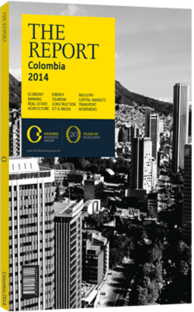OBG talks to José Darío Uribe, Governor, Central Bank of Colombia

Interview: José Darío Uribe
What level of inflation is the central bank aiming for, and what would trigger an interest rate increase?
JOSE DARIO URIBE: Levels of inflation in Colombia are at the lower end of the 2-4% target range. We are aiming at the 3% midpoint; currently, inflation is at levels above 2%. Our predictions for inflation vary between 2.5% and 3% based on different scenarios. While we recognise that Colombia's economy has a slightly negative output gap, it is not at a worrisome level. For example, we have kept the interest rate at 3.25% for more than a year, which implies a real rate that is slightly below 1%, and in May 2014 we raised the rate to 3.5%.
According to the information that we currently possess about the domestic economy, this level is adequate for the goal of stimulating further economic growth. Of course, the figure could change at any time if there was any variation in our projections for growth and inflation – projections that are founded on macroeconomic indicators that we track constantly. Although in the early months of the year the indicator went up a little further than was expected, inflation is expected to end near the point target of 3% in 2014.
What factors guide the central bank's decisions to intervene on behalf of the exchange rate?
URIBE: Colombian monetary policy is based on an inflation-targeting framework with a flexible exchange rate. As a result, decisions regarding the interest rate are based on the combined forecasts of inflation and economic growth. The flexibility of the exchange rate is essential to our framework, and therefore we do not seek to defend any particular level.
However, as our economy continues to grow, we are accumulating international reserves in order to protect the country from external shocks. Such purchases of reserves are entirely transparent and are based on certain criteria. The first factor to consider is that reserves should be kept at appropriate levels for an economy like ours, with growing rates of production, exports, imports and external debt levels. Secondly, an analysis is performed to assess how intense buying should be, depending on what we consider an adequately aligned exchange rate at that moment. At times of unjustified peso appreciation, we intensify the purchase of reserves so as not to compromise the inflation target.
Currently, Colombia has historically high levels of reserves, although some countries have higher reserves than we do. While we are buying dollars at an average of $10m per day, this is small for a market that trades over $1bn daily. It would thus not be unreasonable to increase the purchase of reserves at some point.
To what extent do you foresee the public sector supporting economic growth in the long term?
URIBE: The foremost priority must be to secure the country’s macroeconomic stability. This can be accomplished with the use of three instruments: monetary policy, fiscal policy, and macro and micro prudential policy. Monetary policy needs to ensure price stability and well-anchored inflation expectations. This goes hand in hand with a responsible fiscal policy and regulatory oversight of the financial system. Macroeconomic stability is a necessary but not sufficient condition for long-term growth. Long-term economic growth depends on investing in human and physical capital, in technology, and in the strengthening of our institutions. We need to increase the efficiency of factor markets, especially in labour, capital and land. For example, the labour market in Colombia, as in many other emerging economies, is very segmented, with a large informal sector that is characterised by low productivity. Therefore, we must reduce the extent of informality.
Many Colombians have no access to credit, saving and insurance services. We also need to make sure that all Colombian children have access to adequate nutrition and education. Moreover, we must also improve our judicial system, as well as implement institutional reforms, including improving the security of land rights. Colombia has been constantly improving in all these fields in recent years, but much still remains to be done.
You have reached the limit of premium articles you can view for free.
Choose from the options below to purchase print or digital editions of our Reports. You can also purchase a website subscription giving you unlimited access to all of our Reports online for 12 months.
If you have already purchased this Report or have a website subscription, please login to continue.

